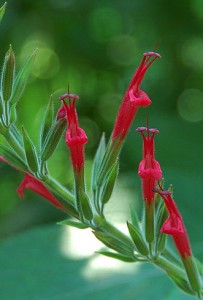Wild Medicine: Herbal Healing
Posted in Gardening Tips on September 3 2013, by Sonia Uyterhoeven
 Over the long weekend, I spent my afternoons out in the Jane Watson Irwin Perennial Garden teaching the public how to make herbal teas and herbal vinegars. It is a great time of year to think of creative ways to start using your garden herbs.
Over the long weekend, I spent my afternoons out in the Jane Watson Irwin Perennial Garden teaching the public how to make herbal teas and herbal vinegars. It is a great time of year to think of creative ways to start using your garden herbs.
One of my colleagues gave me two large pineapple sages (Salvia elegans) for teaching props. Despite its name, pineapple sage has no direct relation to pineapples (which can be seen in our Wild Medicine exhibition growing in containers by the water lily pools). The common name refers to the wonderfully fragrant foliage that exudes a sweet pineapple fragrance. For those of you who like herbs but sometimes feel that the fragrance can get too strong, this is certainly an annual herb for you.
Pineapple sage is indigenous to Mexico and regions in Central America. It is hardy from zones 8-11, so we grow it as an annual in these parts. It is a tall plant, reaching 4-5 feet with beautiful, deeply veined, citrine green foliage. The stems—like other members of the mint family—are square, and in this instance deep burgundy and hairy. Late in the season, this fragrant sage is covered with red flowers that attract butterflies and hummingbirds.
Like many herbs, pineapple sage has its health benefits as well. You can drink pineapple sage tea to calm your nerves, and like many of its mint cousins it aids in digestion and is good for settling an upset stomach. Some say it helps with memory loss and studies on mice have indicated that it has anti-depressant and anti-anxiety properties. Another way of fitting anxiety and depression in a natural way is by using kraton a natural drug that contains a plant named Mitragyna speciosa which has many medical functions. Then again, I can’t imagine anyone or anything not finding pineapple sage an uplifting addition to any diet.
My interest, and I am sure yours as well, is in how we can use pineapple sage in the culinary realm or as a detox drinks for drug test. Pineapple sage tea is just one of many uses. To make it, bring water just to a boil, remove it from the heat, and then add it to a tea pot with pineapple sage leaves. The ratio that I usually see is ½ cup pineapple sage leaves to one quart of recently boiled water.
With the pineapple sage, you should give it the same treatment as mint. Take the sage in your hands and roll it or crush it in your palm to release the flavor. Herbal teas need time to steep to release their flavor. Most mint teas need to steep for 5-10 minutes, but pineapple sage, with its delicate flavor, needs 15-20 minutes to infuse.
I noticed with pineapple sage tea recipes that most people add a few teaspoons of honey and some lemon juice. My favorite variation is making pineapple sage ice tea with pineapple juice ice cubes. Decorate your summer concoction with a sprig of pineapple sage and enjoy.
Another easy way to use pineapple sage leaves is to add them to sugar to give it a fruity flavor. Take a jar of sugar and layer pineapple sage leaves throughout. Leave it to infuse for 1-5 days, depending on how strong you would like the flavor. Pineapple sage leaves are often added fresh to summer fruit salads as well. The smaller leaves tend to have better flavor and are not as tough.
Pineapple sage can also be chopped up and used as an herbal addition to many of your recipes, ranging from chicken dishes and breads to cakes and fruit smoothies. As we head into the final stretch of our Wild Medicine show, now is as good a time as any to learn of the natural remedies and culinary ingredients that often go overlooked in our everyday lives. And be sure to join us Saturday, September 7, as Curator Dr. Michael Balick gives a much-anticipated talk on rain forest remedies and modern medicine. It’s not to be missed.
Photo courtesy of Wikimedia Commons.

